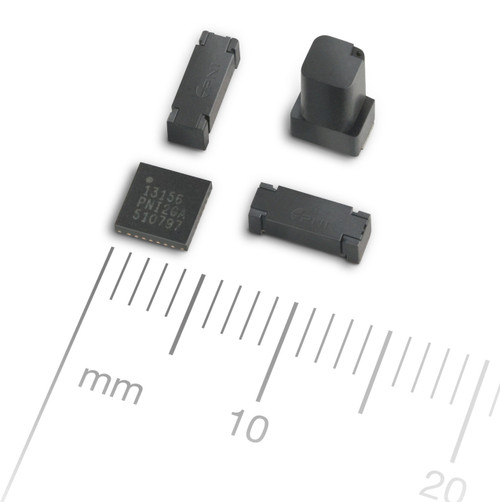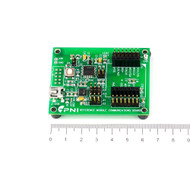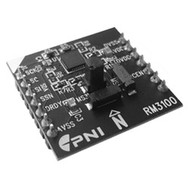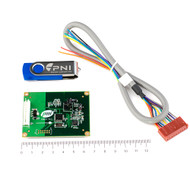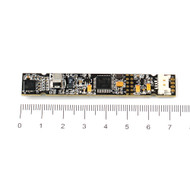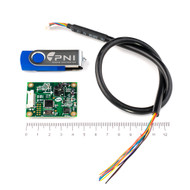- Home
- Digital Compass & Sensors
- Geomagnetic Sensors
- RM3000 Geomagnetic Sensor [CLEARANCE]
Product Description
PNI offers Geomagnetic Sensor Suites comprised of three sensor coils - two Sen - XY sensors and one Sen-Z sensor - plus one of PNI's proprietary ASIC's.
The RM3100 offers improved performance due to a new and improved ASIC, the MagI2C, and offers both SPI and I2C interfaces for easy integration in a wide variety of systems.
The RM3000 remains available to current customers and offers SPI interface with the 3D MagIC ASIC.
The RM3100 Evaluation Board incorporates the RM3100 with peripheral components on a single PCB. It is ideal for evalutaion and prototyping applications.
PNI Sensor’s Geomagnetic Sensors eliminate any “blur” in your magnetic field measurements
Based on PNI’s proprietary magneto-inductive technology, our sensors deliver high-performance resolution and repeatability with extremely low noise. They provide high gain, high sampling rates, and no hysteresis. PNI’s sensors also do not require temperature calibration or current set-and-reset pulses before each measurement. In the graph below, the magnetic field readings of the Hall Effect and PNI’s Magneto Inductive sensors are compared against a figurative “ideal” sensor. The sensors are rotated in a fixed position in a magnetic field of magnitude 2.4 µT while heading data is calculated.
While the Hall Effect sensor is unable to keep a stable reading due to sensor noise, the PNI sensor maintains accurate and consistent readings — no “blur”.
Why Geomagnetic Sensors
Geomagnetic sensors are used to measure the Earth’s magnetic field to provide absolute reference and heading. But a large challenge is the changing magnetic fields that temporarily distort the heading information, such as metal parts in furniture, a passing car, or nearby cell phones and computers. Compensating for these and other transient magnetic anomalies requires the geomagnetic sensor to be able to precisely distinguish between sensor noise (“blur”) and real changes in magnetic field. PNI’s geomagnetic sensors lead the field in their ability to reduce blur to establish the true magnetic field, outperforming other magnetic sensors by orders of magnitude.
Additionally, PNI’s Geomagnetic Sensors are simple to design in, and the peak current requirement is dramatically less than Hall Effect sensors. It isn’t surprising this patented technology has been proven across a wide spectrum of applications, including motion tracking, compassing, game control, TV and set-top box controllers, and magnetic field measurement.
Specifications
| Parameter | Min. | Typical | Max. | |
| Field Measurement Range | -8 Gauss |
| +8 Gauss | |
| Gain at 200 cycle counts * |
| 45 counts / µT |
| |
| Linearity over ±200 µT |
| 0.6% | 1.0 | |
| Noise at 200 cycle counts * | 30 nT | |||
| Data Rate at 200 cycle counts *♦ |
| 150 Hz |
| |
| DC Supply Voltage | 1.6 V | 3.3 V | 3.6 V | |
| Average Current at 12 Hz and 200 cycle counts) | 0.25 mA |
| ||
| DC Resistance vs Temperature |
| 0.4% / C | ||
| Temperature Range - Operation | –40ºC |
| 85ºC | |
| Temperature Range - Storage | –40ºC |
| 85ºC | |
| Size | Sen-XY Sen-Z p/n 13070 Sen-Z p/n 13101 3DMagIC |
| 6.0 x 2.1 x 2.2 mm 3.0 x 3.0 x 5.75 mm 3.9 x 3.0 x 6.35 mm 5.0 x 5.0 x 0.9 mm | |
Downloads
| File | File Type | Description |
| RM3100_Version_5.1.pdf | Spec Sheet | RM3100 Spec Sheet |
| RM3100_Sensor_Suite_User_r03.pdf | User Manual | RM3100 User Manual |
 Loading... Please wait...
Loading... Please wait...
